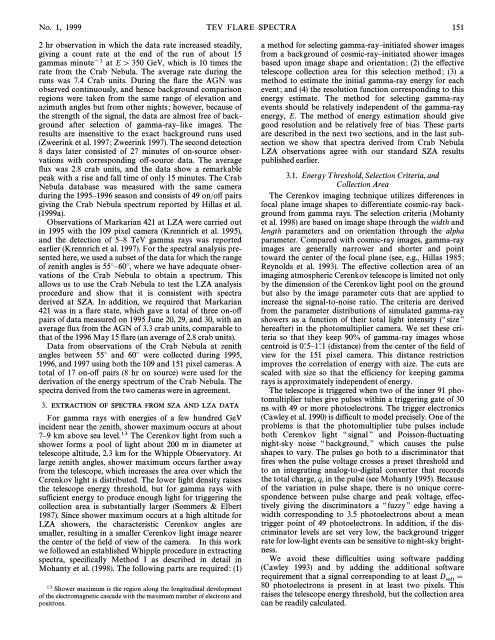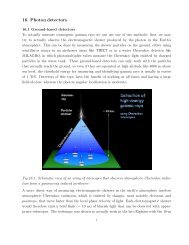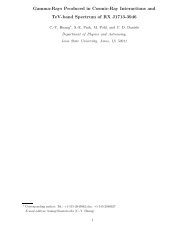Measurement of the Multi-TeV Gamma-Ray Flare Spectra of ...
Measurement of the Multi-TeV Gamma-Ray Flare Spectra of ...
Measurement of the Multi-TeV Gamma-Ray Flare Spectra of ...
You also want an ePaper? Increase the reach of your titles
YUMPU automatically turns print PDFs into web optimized ePapers that Google loves.
No. 1, 1999 TEV FLARE SPECTRA 151<br />
2 hr observation in which <strong>the</strong> data rate increased steadily,<br />
giving a count rate at <strong>the</strong> end <strong>of</strong> <strong>the</strong> run <strong>of</strong> about 15<br />
gammas minute~1 at E [ 350 GeV, which is 10 times <strong>the</strong><br />
rate from <strong>the</strong> Crab Nebula. The average rate during <strong>the</strong><br />
runs was 7.4 Crab units. During <strong>the</strong> Ñare <strong>the</strong> AGN was<br />
observed continuously, and hence background comparison<br />
regions were taken from <strong>the</strong> same range <strong>of</strong> elevation and<br />
azimuth angles but from o<strong>the</strong>r nights; however, because <strong>of</strong><br />
<strong>the</strong> strength <strong>of</strong> <strong>the</strong> signal, <strong>the</strong> data are almost free <strong>of</strong> background<br />
after selection <strong>of</strong> gamma-rayÈlike images. The<br />
results are insensitive to <strong>the</strong> exact background runs used<br />
(Zweerink et al. 1997; Zweerink 1997). The second detection<br />
8 days later consisted <strong>of</strong> 27 minutes <strong>of</strong> on-source observations<br />
with corresponding o†-source data. The average<br />
Ñux was 2.8 crab units, and <strong>the</strong> data show a remarkable<br />
peak with a rise and fall time <strong>of</strong> only 15 minutes. The Crab<br />
Nebula database was measured with <strong>the</strong> same camera<br />
during <strong>the</strong> 1995È1996 season and consists <strong>of</strong> 49 on/o† pairs<br />
giving <strong>the</strong> Crab Nebula spectrum reported by Hillas et al.<br />
(1999a).<br />
Observations <strong>of</strong> Markarian 421 at LZA were carried out<br />
in 1995 with <strong>the</strong> 109 pixel camera (Krennrich et al. 1995),<br />
and <strong>the</strong> detection <strong>of</strong> 5È8 <strong>TeV</strong> gamma rays was reported<br />
earlier (Krennrich et al. 1997). For <strong>the</strong> spectral analysis presented<br />
here, we used a subset <strong>of</strong> <strong>the</strong> data for which <strong>the</strong> range<br />
<strong>of</strong> zenith angles is 55¡È60¡, where we have adequate observations<br />
<strong>of</strong> <strong>the</strong> Crab Nebula to obtain a spectrum. This<br />
allows us to use <strong>the</strong> Crab Nebula to test <strong>the</strong> LZA analysis<br />
procedure and show that it is consistent with spectra<br />
derived at SZA. In addition, we required that Markarian<br />
421 was in a Ñare state, which gave a total <strong>of</strong> three on-o†<br />
pairs <strong>of</strong> data measured on 1995 June 20, 29, and 30, with an<br />
average Ñux from <strong>the</strong> AGN <strong>of</strong> 3.3 crab units, comparable to<br />
that <strong>of</strong> <strong>the</strong> 1996 May 15 Ñare (an average <strong>of</strong> 2.8 crab units).<br />
Data from observations <strong>of</strong> <strong>the</strong> Crab Nebula at zenith<br />
angles between 55¡ and 60¡ were collected during 1995,<br />
1996, and 1997 using both <strong>the</strong> 109 and 151 pixel cameras. A<br />
total <strong>of</strong> 17 on-o† pairs (8 hr on source) were used for <strong>the</strong><br />
derivation <strong>of</strong> <strong>the</strong> energy spectrum <strong>of</strong> <strong>the</strong> Crab Nebula. The<br />
spectra derived from <strong>the</strong> two cameras were in agreement.<br />
3. EXTRACTION OF SPECTRA FROM SZA AND LZA DATA<br />
For gamma rays with energies <strong>of</strong> a few hundred GeV<br />
incident near <strong>the</strong> zenith, shower maximum occurs at about<br />
7È9 km above sea level.13 The Cerenkov light from such a<br />
shower forms a pool <strong>of</strong> light about 200 m in diameter at<br />
telescope altitude, 2.3 km for <strong>the</strong> Whipple Observatory. At<br />
large zenith angles, shower maximum occurs far<strong>the</strong>r away<br />
from <strong>the</strong> telescope, which increases <strong>the</strong> area over which <strong>the</strong><br />
Cerenkov light is distributed. The lower light density raises<br />
<strong>the</strong> telescope energy threshold, but for gamma rays with<br />
sufficient energy to produce enough light for triggering <strong>the</strong><br />
collection area is substantially larger (Sommers & Elbert<br />
1987). Since shower maximum occurs at a high altitude for<br />
LZA showers, <strong>the</strong> characteristic Cerenkov angles are<br />
smaller, resulting in a smaller Cerenkov light image nearer<br />
<strong>the</strong> center <strong>of</strong> <strong>the</strong> Ðeld <strong>of</strong> view <strong>of</strong> <strong>the</strong> camera. In this work<br />
we followed an established Whipple procedure in extracting<br />
spectra, speciÐcally Method I as described in detail in<br />
Mohanty et al. (1998). The following parts are required: (1)<br />
13 Shower maximum is <strong>the</strong> region along <strong>the</strong> longitudinal development<br />
<strong>of</strong> <strong>the</strong> electromagnetic cascade with <strong>the</strong> maximum number <strong>of</strong> electrons and<br />
positrons.<br />
a method for selecting gamma-rayÈinitiated shower images<br />
from a background <strong>of</strong> cosmic-rayÈinitiated shower images<br />
based upon image shape and orientation; (2) <strong>the</strong> e†ective<br />
telescope collection area for this selection method; (3) a<br />
method to estimate <strong>the</strong> initial gamma-ray energy for each<br />
event; and (4) <strong>the</strong> resolution function corresponding to this<br />
energy estimate. The method for selecting gamma-ray<br />
events should be relatively independent <strong>of</strong> <strong>the</strong> gamma-ray<br />
energy, E. The method <strong>of</strong> energy estimation should give<br />
good resolution and be relatively free <strong>of</strong> bias. These parts<br />
are described in <strong>the</strong> next two sections, and in <strong>the</strong> last subsection<br />
we show that spectra derived from Crab Nebula<br />
LZA observations agree with our standard SZA results<br />
published earlier.<br />
3.1. Energy T hreshold, Selection Criteria, and<br />
Collection Area<br />
The Cerenkov imaging technique utilizes di†erences in<br />
focal plane image shapes to di†erentiate cosmic-ray background<br />
from gamma rays. The selection criteria (Mohanty<br />
et al. 1998) are based on image shape through <strong>the</strong> width and<br />
length parameters and on orientation through <strong>the</strong> alpha<br />
parameter. Compared with cosmic-ray images, gamma-ray<br />
images are generally narrower and shorter and point<br />
toward <strong>the</strong> center <strong>of</strong> <strong>the</strong> focal plane (see, e.g., Hillas 1985;<br />
Reynolds et al. 1993). The e†ective collection area <strong>of</strong> an<br />
imaging atmospheric Cerenkov telescope is limited not only<br />
by <strong>the</strong> dimension <strong>of</strong> <strong>the</strong> Cerenkov light pool on <strong>the</strong> ground<br />
but also by <strong>the</strong> image parameter cuts that are applied to<br />
increase <strong>the</strong> signal-to-noise ratio. The criteria are derived<br />
from <strong>the</strong> parameter distributions <strong>of</strong> simulated gamma-ray<br />
showers as a function <strong>of</strong> <strong>the</strong>ir total light intensity (““ size ÏÏ<br />
hereafter) in <strong>the</strong> photomultiplier camera. We set <strong>the</strong>se criteria<br />
so that <strong>the</strong>y keep 90% <strong>of</strong> gamma-ray images whose<br />
centroid is 0¡.5È1¡.1 (distance) from <strong>the</strong> center <strong>of</strong> <strong>the</strong> Ðeld <strong>of</strong><br />
view for <strong>the</strong> 151 pixel camera. This distance restriction<br />
improves <strong>the</strong> correlation <strong>of</strong> energy with size. The cuts are<br />
scaled with size so that <strong>the</strong> efficiency for keeping gamma<br />
rays is approximately independent <strong>of</strong> energy.<br />
The telescope is triggered when two <strong>of</strong> <strong>the</strong> inner 91 photomultiplier<br />
tubes give pulses within a triggering gate <strong>of</strong> 30<br />
ns with 49 or more photoelectrons. The trigger electronics<br />
(Cawley et al. 1990) is difficult to model precisely. One <strong>of</strong> <strong>the</strong><br />
problems is that <strong>the</strong> photomultiplier tube pulses include<br />
both Cerenkov light ““ signal ÏÏ and Poisson-Ñuctuating<br />
night-sky noise ““ background, ÏÏ which causes <strong>the</strong> pulse<br />
shapes to vary. The pulses go both to a discriminator that<br />
Ðres when <strong>the</strong> pulse voltage crosses a preset threshold and<br />
to an integrating analog-to-digital converter that records<br />
<strong>the</strong> total charge, q, in <strong>the</strong> pulse (see Mohanty 1995). Because<br />
<strong>of</strong> <strong>the</strong> variation in pulse shape, <strong>the</strong>re is no unique correspondence<br />
between pulse charge and peak voltage, e†ectively<br />
giving <strong>the</strong> discriminators a ““ fuzzy ÏÏ edge having a<br />
width corresponding to 3.5 photoelectrons about a mean<br />
trigger point <strong>of</strong> 49 photoelectrons. In addition, if <strong>the</strong> discriminator<br />
levels are set very low, <strong>the</strong> background trigger<br />
rate for low-light events can be sensitive to night-sky brightness.<br />
We avoid <strong>the</strong>se difficulties using s<strong>of</strong>tware padding<br />
(Cawley 1993) and by adding <strong>the</strong> additional s<strong>of</strong>tware<br />
requirement that a signal corresponding to at least D \<br />
80 photoelectrons is present in at least two pixels. s<strong>of</strong>t<br />
This<br />
raises <strong>the</strong> telescope energy threshold, but <strong>the</strong> collection area<br />
can be readily calculated.







